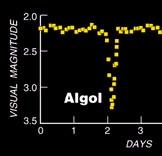Beta Lyrae is one of the easiest variable stars to find and observe, and also one of the most fascinating from a scientific point of view.

S&T Illustration
Like the much better-known Algol, Beta Lyrae is an eclipsing binary. In other words, it's a pair of stars in a very tight orbit that's oriented nearly edge-on to our line of sight. At least one of the stars periodically blocks the other one, causing the combined light of the pair to become dimmer. The primary eclipse happens when the brighter star is blocked. Some eclipsing binaries (including Beta Lyrae but not Algol) also have a prominent secondary eclipse when the brighter star passes in front of the fainter one.
Algol's eclipses are dramatic but brief; the star fades to just one-third of its normal brightness in five hours, and recovers equally quickly. That makes it easy to tell when one of Algol's eclipses is happening, but it also means that there are relatively few good opportunities to view one.

Click above for a larger image.
Sky & Telescope illustration.
Beta Lyrae is at the opposite extreme; its light varies gently and continuously over its 12.9-day period, as shown at right. So if you look carefully, you have a pretty good chance of catching this star when it's significantly below maximum brightness on any given night. View a larger chart of Beta Lyrae's light curve.
You can estimate Beta's brightness by comparing it with the other five stars that make up Lyra's distinctive geometric shape. At its brightest, Beta is a near-twin of nearby Gamma Lyrae. But at the deepest part of its primary eclipse, Beta is the faintest (by a small margin) of Lyra's signature stars.
Beta Lyrae's gentle variation results from the fact that its components are so close to each other that they distort each other's shape and exchange material between them. Read more about the fascinating physics behind this star, by the American Association of Variable Star Observers (AAVSO).
J. M. Kreiner of the Mt. Suhora Astronomical Observatory in Poland maintains a website that
predicts the eclipses for a huge number of eclipsing binaries..
See his latest predictions for Beta Lyrae.
Beta Lyrae and Algol are two of the Top 12 Naked-Eye Variable Stars selected by notable variable-star observer John Isles in our May 1997 issue.
 0
0
Comments
You must be logged in to post a comment.